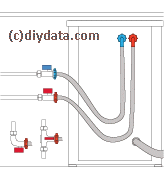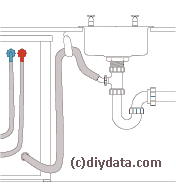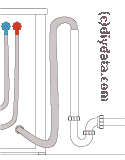Connecting a washing machine or dishwasher
Connecting either a domestic washing machine or a dishwasher is fairly straight forward, all you need is:
- Water supply - some washing machines require hot and cold water supplies, other washing machines and almost all dishwashers need just a cold water supply,
- Drainage for the waste water,
and - An electrical supply via a 13A socket.
When choosing a place to install the machine, take these needs into account to minimise the work involved. Next to the sink may be ideal as it will be near the existing water supplies and drainage.
Water supply
Some washing machines require both hot and cold water supplies, other washing machines and almost all dishwashers need just a cold water supply. Check the literature supplied with the machine, it should state the required water pressure.
A water tank 10 metres above the outlet is equivalent to 100kPa (KiloPascels) or about 1 bar. In the UK mains water pressure varies quite a bit, in older properties it can be less than 1 bar (100kPa) but the average pressure tends to be about 3 bar (300kPa) during the day and drops slightly at times of peak usage. At times of low usage (i.e. late evening and early hours of the morning), the pressure rises, and can go up towards 10 bar (1000kPa or 1MPa).
Most machines are designed to use mains water directly connected, so you should only run into problems if you intend to use a tank supply with a small vertical distance to the water tank.
The washing machine/dishwasher will come with flexible hose or hoses with screw connections at each end for connecting the machine to the water supply (3/4 inch BSP).
Inline valves
 The water supply needs to be via an inline valve so that the supply can be isolated when necessary. Two types of valve are available, those with a Check Valve incorporated to prevent flow back of water in fault conditions and those without Check Valves - inline valves with Check Valves should be used when connecting directly to the mains.
The water supply needs to be via an inline valve so that the supply can be isolated when necessary. Two types of valve are available, those with a Check Valve incorporated to prevent flow back of water in fault conditions and those without Check Valves - inline valves with Check Valves should be used when connecting directly to the mains.
 The Inline Valves are fairly standard for connecting to 15mm copper pipework although there are a number of styles for the outlet. Shown to the right are three compression fittings - offering straight in-line, an elbow and a tee-piece outlets. Usually Inline Valves are sold singly with two knobs (red and blue) so you just have to fit the appropriate one.
The Inline Valves are fairly standard for connecting to 15mm copper pipework although there are a number of styles for the outlet. Shown to the right are three compression fittings - offering straight in-line, an elbow and a tee-piece outlets. Usually Inline Valves are sold singly with two knobs (red and blue) so you just have to fit the appropriate one.
 Two other options are a push-on valve and a self cutting valve as shown to the right.
Two other options are a push-on valve and a self cutting valve as shown to the right.
Pipework
Run the pipework to near the position for the washing machine/dishwasher, the hoses supplied are normally about 1.5 metres long but are not intended to be pulled tight and, ideally, should form a gentle loop.
With the water supplies disconnected and drained, connect into the existing pipework as necessary. Even having drained the water, there may still be some water left in the pipes so be ready with a bowl and cloth to soak up any water spill.
Where the existing pipework has compression couplings, it should be easy to disconnect these, cut the pipes as required and add the extra pipework. If there happens to be an existing rightangle elbow conveniently positioned, it may be possible to change this for a Tee piece so that the additional pipework can be connected without cutting any existing pipe.
Where the existing pipework incorporates soldered couplings, the pipework will need to be cut through. Do not use solder couplings to remake the joints unless you can drain the water to well below them (any water in the pipes may stop the joints from reaching a high enough temperature to make a reliable joint). If you do use solder joints, make sure that the taps are open so that there is no steam build up in the pipes. Alternatives are to use compression or push-fit connectors.
Where the existing pipework incorporates push-fit couplings, the pipework can normally be dismantled and reused to make up the new pipework.
Secure the pipework to the walls using pipe clips, position one fairly near each Inline Valve so that they are well supported.
Drainage for the waste water
The literature for the machine will probably define both a minimum and a maximum height for the waste discharge hose above floor level - effectively above the bottom of the machine. Providing these heights can be achieved, there are three options available for dealing with the waste:
- Place the waste hose from the machine into the sink when required - obviously making sure that the waste plug is not in place.
- Permanently connect the waste hose from the machine into the existing waste pipe.
- Permanently connect the waste hose from the machine to a dedicated waste outlet.
Using existing waste pipe.
 If the washing machine is close to the sink, it may be possible to alter the current waste trap to accept the waste water from the machine - a typical example is shown to the right.
If the washing machine is close to the sink, it may be possible to alter the current waste trap to accept the waste water from the machine - a typical example is shown to the right.
In theory, all you have to do is to connect the washing machine waste hose to the spigot on the side of the waste trap underneath the sink. The only problem is that the existing waste trap probably won't have a spigot fitted, and fitting a suitable trap may lower the outlet to below the existing waste pipe, so further changes to the waste pipe may be necessary.
Do not use a trap where the spigot is in the bend of the trap, this may cause the water in the machine to be siphoned out.
If you can use this method, it is the easiest but make sure that the top of the waste hose from the machine is higher than the waste trap and also that the top of the waste hose is within the limits specified in the literature - use a screw under the worktop to hold up the pipe as shown if necessary.
Using a dedicated waste outlet.
 Where the waste from the machine cannot be fed into the trap, the option is to have a dedicated waste outlet. Basically it is a vertical pipe with a water trap at the lower end. This waste pipe must connect to the foul water sewer and not a rain water soakaway.
Where the waste from the machine cannot be fed into the trap, the option is to have a dedicated waste outlet. Basically it is a vertical pipe with a water trap at the lower end. This waste pipe must connect to the foul water sewer and not a rain water soakaway.
The foul water sewer can easily be identified as this is where the waste from the kitchen sink, toilet, bath etc goes. Connection can be made to a suitable waste pipe in the property, otherwise a hole through the outside wall to take the waste pipe (normally 40mm dia) will be required at the level of the outlet from the waste trap.
See our article for connecting waste pipes to household drains for more details.
